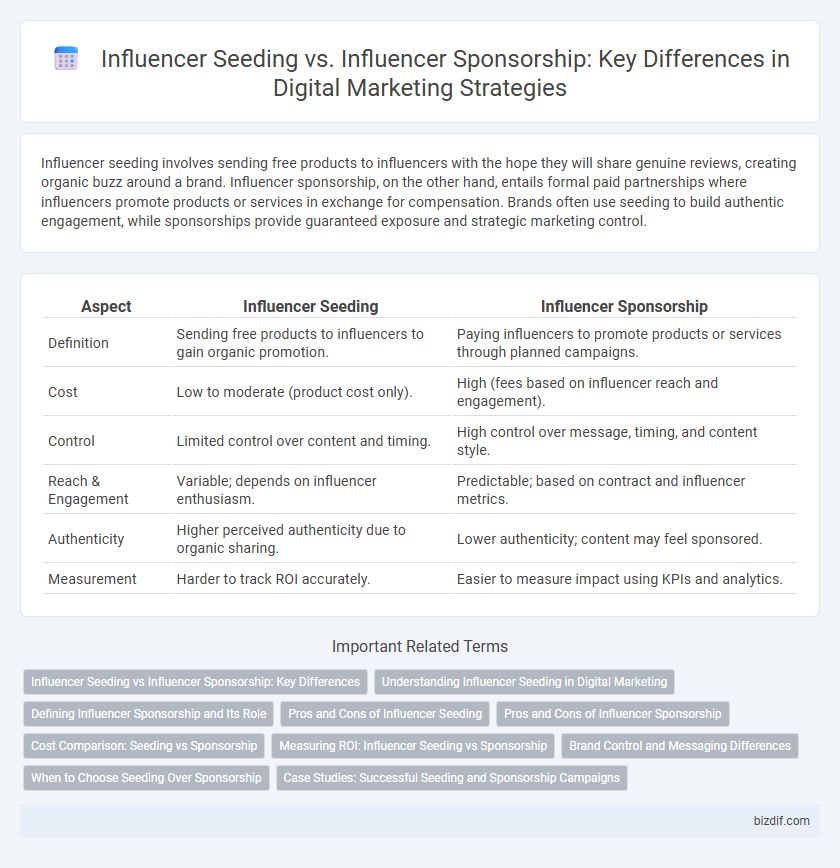Influencer seeding involves sending free products to influencers with the hope they will share genuine reviews, creating organic buzz around a brand. Influencer sponsorship, on the other hand, entails formal paid partnerships where influencers promote products or services in exchange for compensation. Brands often use seeding to build authentic engagement, while sponsorships provide guaranteed exposure and strategic marketing control.
Table of Comparison
| Aspect | Influencer Seeding | Influencer Sponsorship |
|---|---|---|
| Definition | Sending free products to influencers to gain organic promotion. | Paying influencers to promote products or services through planned campaigns. |
| Cost | Low to moderate (product cost only). | High (fees based on influencer reach and engagement). |
| Control | Limited control over content and timing. | High control over message, timing, and content style. |
| Reach & Engagement | Variable; depends on influencer enthusiasm. | Predictable; based on contract and influencer metrics. |
| Authenticity | Higher perceived authenticity due to organic sharing. | Lower authenticity; content may feel sponsored. |
| Measurement | Harder to track ROI accurately. | Easier to measure impact using KPIs and analytics. |
Influencer Seeding vs Influencer Sponsorship: Key Differences
Influencer seeding involves sending free products to influencers without guaranteed promotion, relying on organic content creation, whereas influencer sponsorship entails formal agreements with paid compensation for specified promotional activities. Seeding focuses on authentic brand exposure through genuine influencer enthusiasm, while sponsorship ensures targeted messaging and measurable campaign outcomes. Brands often use seeding for early-stage awareness and sponsorship for controlled, large-scale marketing efforts.
Understanding Influencer Seeding in Digital Marketing
Influencer seeding in digital marketing involves providing products or services to influencers without direct payment, encouraging organic promotion and authentic engagement with their audience. Unlike influencer sponsorship, which typically includes formal contracts and financial compensation, seeding builds relationships through trust and subtle brand integration. This strategy leverages the influencer's credibility to drive brand awareness and genuine user interest, often resulting in higher long-term impact.
Defining Influencer Sponsorship and Its Role
Influencer sponsorship involves financially compensating influencers to promote a brand's products or services, ensuring consistent and controlled messaging across targeted audiences. This strategy enhances brand visibility and credibility by leveraging the influencer's established trust and reach within their niche. Unlike influencer seeding, which relies on gifting products without formal agreements, sponsorship guarantees a measurable return on investment through contractual engagement and performance tracking.
Pros and Cons of Influencer Seeding
Influencer seeding offers cost-effective brand exposure by gifting products to influencers without upfront payments, allowing organic promotion and authentic content creation that resonates with target audiences. However, the lack of guaranteed delivery or specific messaging control presents risks, as influencers may choose not to post or misalign with brand objectives, limiting campaign predictability and measurable ROI. Compared to influencer sponsorship, seeding benefits from spontaneity and credibility but sacrifices the structured partnership and assured visibility typical of paid collaborations.
Pros and Cons of Influencer Sponsorship
Influencer sponsorship offers brands direct control over campaign messaging and allows for measurable ROI through specific deliverables and timelines. However, sponsorships can be costly, often requiring substantial budgets for high-profile influencers, and may risk authenticity if the promotion appears too commercialized. Despite these downsides, influencer sponsorships enhance brand visibility and provide consistent content aligned with marketing objectives.
Cost Comparison: Seeding vs Sponsorship
Influencer seeding typically involves sending free products or services to influencers at minimal cost, making it a budget-friendly strategy for brand exposure. Influencer sponsorship requires direct payments, which can range from hundreds to thousands of dollars per post depending on the influencer's reach and engagement metrics. Brands often weigh the lower upfront cost of seeding against the guaranteed content and broader reach offered by sponsorship to optimize their digital marketing budgets.
Measuring ROI: Influencer Seeding vs Sponsorship
Measuring ROI in influencer seeding focuses on engagement metrics such as likes, comments, and organic reach, offering insights into audience receptivity without direct sales tracking. Influencer sponsorship allows for more precise ROI measurement through tracked links, promo codes, and conversion rates, providing clear data on sales impact and revenue generated. Brands seeking measurable financial returns often prioritize sponsorships, while seeding is valued for brand awareness and authentic audience connections.
Brand Control and Messaging Differences
Influencer seeding offers brands minimal control over messaging as content is created organically by influencers who receive free products, leading to authentic but less predictable brand representation. Influencer sponsorship involves formal agreements with clear guidelines and deliverables, allowing brands to maintain tighter control over messaging and ensure alignment with marketing objectives. The choice between seeding and sponsorship significantly impacts brand consistency, with sponsorship providing structured brand control and seeding fostering genuine consumer trust.
When to Choose Seeding Over Sponsorship
Influencer seeding is ideal for brands aiming to generate organic awareness by gifting products without committing to paid contracts, especially when targeting micro-influencers with engaged niche audiences. Choosing seeding over sponsorship works best during early-stage campaigns where authenticity and user-generated content drive credibility and cost efficiency. This strategy suits brands with limited budgets seeking to test market response before scaling to larger sponsored influencer partnerships.
Case Studies: Successful Seeding and Sponsorship Campaigns
Case studies reveal that influencer seeding campaigns, such as Daniel Wellington's organic watch gifting strategy, generate authentic user-generated content and high engagement rates without direct payment. Influencer sponsorship initiatives like the Gymshark x fitness influencers collaboration demonstrate measurable ROI through targeted brand exposure and sales growth. Comparing both approaches highlights how seeding fosters trust and community, while sponsorship drives scalability and controlled messaging.
Influencer seeding vs Influencer sponsorship Infographic

 bizdif.com
bizdif.com